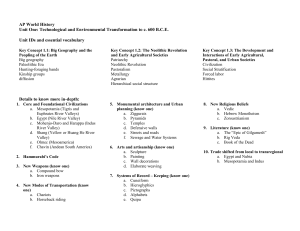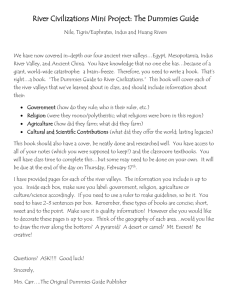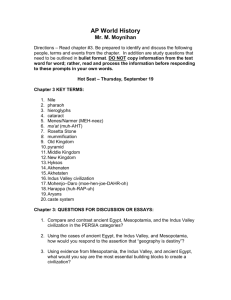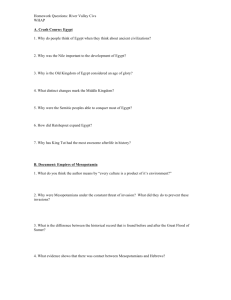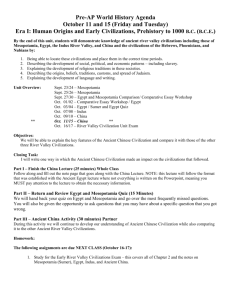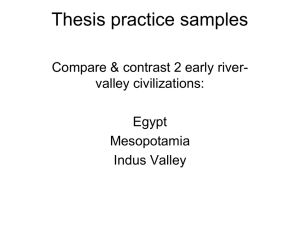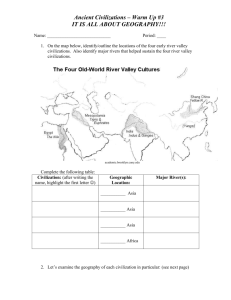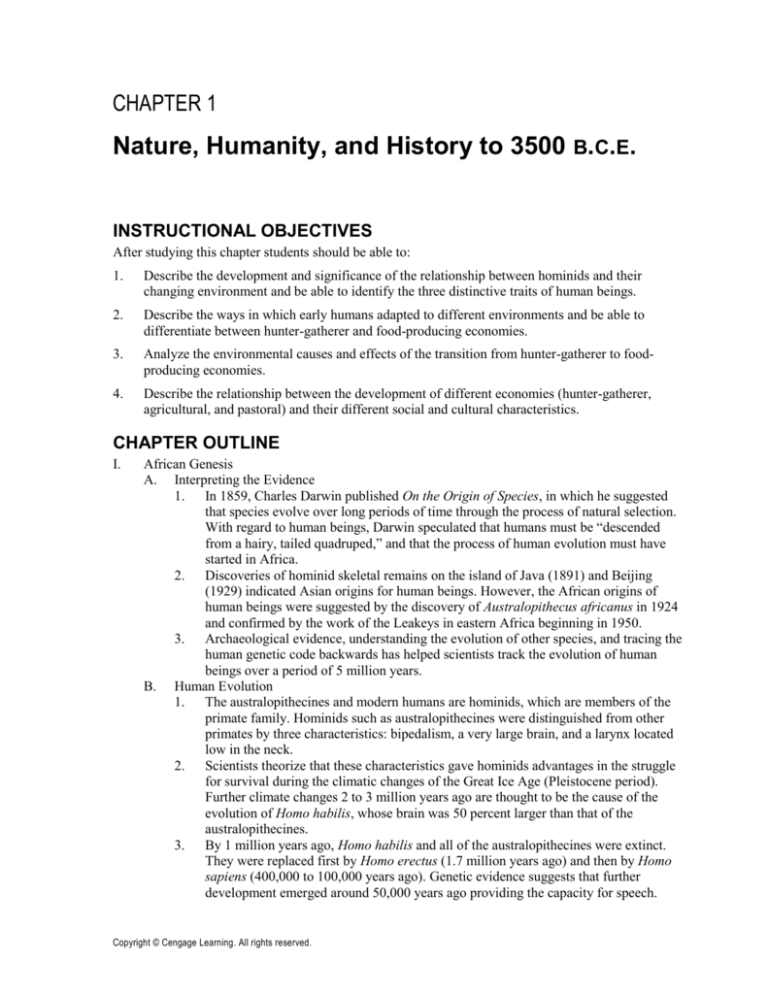
CHAPTER 1
Nature, Humanity, and History to 3500 B.C.E.
INSTRUCTIONAL OBJECTIVES
After studying this chapter students should be able to:
1.
Describe the development and significance of the relationship between hominids and their
changing environment and be able to identify the three distinctive traits of human beings.
2.
Describe the ways in which early humans adapted to different environments and be able to
differentiate between hunter-gatherer and food-producing economies.
3.
Analyze the environmental causes and effects of the transition from hunter-gatherer to foodproducing economies.
4.
Describe the relationship between the development of different economies (hunter-gatherer,
agricultural, and pastoral) and their different social and cultural characteristics.
CHAPTER OUTLINE
I.
African Genesis
A. Interpreting the Evidence
1. In 1859, Charles Darwin published On the Origin of Species, in which he suggested
that species evolve over long periods of time through the process of natural selection.
With regard to human beings, Darwin speculated that humans must be “descended
from a hairy, tailed quadruped,” and that the process of human evolution must have
started in Africa.
2. Discoveries of hominid skeletal remains on the island of Java (1891) and Beijing
(1929) indicated Asian origins for human beings. However, the African origins of
human beings were suggested by the discovery of Australopithecus africanus in 1924
and confirmed by the work of the Leakeys in eastern Africa beginning in 1950.
3. Archaeological evidence, understanding the evolution of other species, and tracing the
human genetic code backwards has helped scientists track the evolution of human
beings over a period of 5 million years.
B. Human Evolution
1. The australopithecines and modern humans are hominids, which are members of the
primate family. Hominids such as australopithecines were distinguished from other
primates by three characteristics: bipedalism, a very large brain, and a larynx located
low in the neck.
2. Scientists theorize that these characteristics gave hominids advantages in the struggle
for survival during the climatic changes of the Great Ice Age (Pleistocene period).
Further climate changes 2 to 3 million years ago are thought to be the cause of the
evolution of Homo habilis, whose brain was 50 percent larger than that of the
australopithecines.
3. By 1 million years ago, Homo habilis and all of the australopithecines were extinct.
They were replaced first by Homo erectus (1.7 million years ago) and then by Homo
sapiens (400,000 to 100,000 years ago). Genetic evidence suggests that further
development emerged around 50,000 years ago providing the capacity for speech.
Copyright © Cengage Learning. All rights reserved.
2
Chapter 1: Nature, Humanity, and History to 3500 B.C.E.
C.
Migrations from Africa
1. Both Homo erectus and Homo sapiens migrated from Africa to various parts of Europe
and Asia; their migration was facilitated by the low sea levels associated with the Ice
Age. Homo sapiens migrated from Africa during a wet period (40,000 years ago) and
crossed the land bridge to the Americas during the last glacial period (32,000–13,000
years ago). The low sea levels associated with this period also allowed Homo sapiens
to reach Japan and New Guinea/Australia.
2. These migrations were accompanied by very minor physical evolutionary changes such
as changes in skin pigmentation. For the most part, however, humans adapted to their
new environments not through biological evolution but through a process of
technological adaptation.
II. History and Culture in the Ice Age
A. Food Gathering and Stone Tools
1. The period known as the Stone Age lasted from 2 million years ago to 4,000 years ago.
It is subdivided into the Paleolithic (Old Stone Age—to 10,000 years ago) and the
Neolithic (New Stone Age).
2. The Paleolithic age is characterized by the production of stone tools that were used in
scavenging meat from dead animals and later in hunting. Homo sapiens proved to be
particularly good hunters and may have caused or helped to cause the extinction of
mastodons and mammoths about 11,000 years ago.
3. The diet of Stone Age people probably consisted more of foraged vegetable foods than
of meat. Human use of fire can be traced back to 1.5 million years ago, but conclusive
evidence of cooking (in the form of clay pots) can only be found as far back as 12,500
years ago.
B. Gender Roles and Social Life
1. The slow maturation rate of human infants and the ability of adult humans to mate at
any time of the year are thought to be causes of the development of the two-parent
family that is one of the characteristics of the hominids.
2. Researchers believe that in Ice Age society, women would have been responsible for
gathering, cooking, and child-care, while men would have been responsible for
hunting. The hunter-gatherers probably lived in fairly small groups and migrated
regularly to follow game animals and to take advantage of seasonal variations in the
ripening of foraged foods.
C. Hearths and Cultural Expressions
1. Migrating hunter-gatherer groups lived in camps, using natural shelter when available
and building temporary shelters when the climate required it; permanently established
fishing communities made more solid structures. Clothing was made of animal skins
sewn together with vegetable fiber and rawhide cords.
2. Hunter-gatherers probably had to spend no more than three to five hours a day on
getting food, clothing, and shelter. This left them a certain amount of time for cultural
activities: gathering, organizing and passing on information, art, and religion.
3. Cave art suggests that Ice Age people had a complex religion. Their burial sites
indicate that they may have believed in an afterlife.
III. The Agricultural Revolutions
A. The Transition to Plant Cultivation
1. Agricultural revolutions—the domestication of plants and animals—were a series of
changes in food production that occurred independently in various parts of the world.
Changes in global climate were probably the cause of these transformations.
2. The first stage of the long process of domestication of plants was semicultivation, in
which people would scatter the seeds of desirable food-producing plants in places
Copyright © Cengage Learning. All rights reserved.
Chapter 1: Nature, Humanity, and History to 3500 B.C.E.
3
where they would be likely to grow. The next stage was the use of fire to clear fields
and specialized tools to plant and harvest grain.
3. The transition to agriculture took place first and is best documented in the Middle East,
but the same sort of transition took place independently in other parts of the world,
including the eastern Sahara, the Nile Valley, Greece, and Central Europe. Early
farmers practiced swidden agriculture, changing fields periodically as the fertility of
the soil became depleted.
4. The environments in which agriculture developed dictated the choice of crops. Wheat
and barley were suited to the Mediterranean area; sorghum, millet, and teff to subSaharan Africa; yams to Equatorial West Africa; rice to eastern and southern Asia, and
maize, potatoes, quinoa, and manioc to various parts of the Americas.
B. Domesticated Animals and Pastoralism
1. Domestication of animals proceeded at the same time as domestication of plants.
Human hunters first domesticated dogs; sheep and goats were later domesticated for
their meat, milk, and wool.
2. As with plants, domestication of animals occurred independently in various parts of the
world, and the animals domesticated were those that suited the local environment. In
most parts of the world, the domestication of plants went along with the domestication
of animals because animals were used for pulling plows and supplied manure for
fertilizer.
3. There were two exceptions to the pattern of plant and animal domestication
accompanying one another. In the Americas, there were no animals suitable for
domestication other than llamas, guinea pigs, and some fowl, and so hunting remained
the main source of meat, and humans the main source of labor power. In the arid parts
of Central Asia and Africa, the environment was not appropriate for settled agriculture,
but it could support pastoralists who herded cattle or other animals from one grazing
area to another.
C. Agriculture and Ecological Crisis
1. Most researchers agree that humans made the transition from hunter-gatherer to
agricultural or pastoralist economies because the global warming between 6000 and
2000 B.C.E. brought with it environmental changes that reduced the supplies of game
and wild food plants. The agricultural revolutions brought about a significant increase
in the world’s human population—from 10 million in 5000 B.C.E. to between 50 and
100 million in 1000 B.C.E.
IV. Life in Neolithic Communities
A. Cultural Expressions
1. The early food producers appear to have worshiped ancestral and nature spirits. Their
religions centered on sacred groves, springs, and wild animals and included deities
such as the Earth Mother and the Sky God. Some of these beliefs may be reflected in
ancient Hindu texts.
2. Early food-producing societies used megaliths (big stones) to construct burial
chambers and calendar circles and to aid in astronomical observations.
3. The expansion of food-producing societies may be reflected in the patterns in which
the Indo-European, Sino-Tibetan, and Afro-Asiatic language groups are dispersed
around the Eastern Hemisphere.
B. Early Towns and Specialists
1. Most people in early food-producing societies lived in villages, but in some places, the
environment supported the growth of towns in which one finds more elaborate
dwellings, facilities for surplus food storage, and communities of specialized
craftspeople. The two best-known examples of the remains of Neolithic towns are at
Copyright © Cengage Learning. All rights reserved.
4
V.
Chapter 1: Nature, Humanity, and History to 3500 B.C.E.
Jericho and Çatal Hüyük. Jericho, on the west bank of the Jordan River, was a walled
town with mud-brick structures and dates back to 8000 B.C.E.
2. Çatal Hüyük, in central Turkey, dates to 7000–5000 B.C.E. Çatal Hüyük was a center
for the trade in obsidian. Its craftspeople produced pottery, baskets, woolen cloth,
beads, and leather and wood products. There is no evidence of a dominant class or
centralized political leadership.
3. The art of Çatal Hüyük reflects a continued fascination with hunting, but the remains
indicate that agriculture was the mainstay of the economy. The remains also indicate
that the people of Çatal Hüyük had a flourishing religion that involved offerings of
food. Evidence indicates that the religion may have centered on the worship of a
goddess and may have been administered by priestesses.
4. The remains at Çatal Hüyük include decorative or ceremonial objects made of copper,
lead, silver, and gold. These metals are naturally occurring, soft, and easy to work, but
not suitable for tools or weapons, which continued to be made from stone.
5. The presence of towns like Jericho and Çatal Hüyük indicates the emergence of a form
of social organization in which food producers had to support nonproducing specialists
such as priests and craftspeople and their labor had to be mobilized for nonproductive
projects such as defensive walls, megalithic structures, and tombs. We do not know
whether this labor was free or coerced.
Conclusion
A. Humans are descended from hominids that evolved in Africa about 7 million years ago.
Modern human beings are descended from communities that evolved in Africa 50,000 years
ago.
B. Humans began developing a variety of tools more than 2 million years ago from stone, bone,
skin, wood, and plant fiber. Though primarily vegetarian, Paleolithic people also used
weapons to hunt. They developed a sexual division of labor and became knowledgeable
about the natural world that provided them with clothing and medicine.
C. Climate change drove early human communities to abandon hunting and gathering and
develop agriculture and pastoralism, which consequently increased the global human
population from 2 to 10 million in less than 10,000 years.
D. Prosperity of the settled life during the Neolithic period led to the first towns, trade, and
specialization. Archaeology reveals that humans developed forms of religion to recognize
the cycles of death and rebirth.
DISCUSSION QUESTIONS
1.
How did the physical and cultural characteristics of hominids change over time, and how do
scientists document and explain these changes?
2.
How have changes in the environment influenced the physical development of the human species?
3.
What is culture? Do environmental conditions and changes in the techniques of production have
an effect on culture? If so, how?
4.
What effects did the agricultural revolutions have on Neolithic societies?
5.
What were women’s roles in the first 4 million years of human history? What evidence can we
find that might give us some indications of what women’s roles may have been? Does the
evidence indicate how women’s roles may have changed over time? How and why might such
change have occurred?
Copyright © Cengage Learning. All rights reserved.
Chapter 1: Nature, Humanity, and History to 3500 B.C.E.
5
The First River-Valley Civilizations,
3500–1500 B.C.E.
INSTRUCTIONAL OBJECTIVES
After studying this chapter students should be able to:
1.
Explain how the earliest civilizations developed in challenging environments.
2.
Draw connections between the organization of labor resources in early civilizations and their
social and political structures.
3.
Assess the impact of new technologies on the social development of early civilizations.
4.
Trace the development of social and political institutions and religious beliefs in river-valley
civilizations and understand the relationship between these institutions and beliefs and their
experiences with the natural environment.
CHAPTER OUTLINE
I.
Mesopotamia
A. Settled Agriculture in an Unstable Landscape
1. Mesopotamia is the alluvial plain area alongside and between the Tigris and Euphrates
Rivers. The area is a difficult environment for agriculture because there is little rainfall,
the rivers flood at the wrong time for grain agriculture, and the rivers change course
unpredictably.
2. Mesopotamia does have a warm climate and good soil. By 4000 B.C.E., farmers were
using cattle-pulled plows and a sort of planter to cultivate barley. Just after 3000 B.C.E.,
they began constructing irrigation canals to bring water to fields farther away from the
rivers.
3. Other crops and natural resources of the area included date palms, vegetables, reeds
and fish, and fallow land for grazing goats and sheep. Draft animals included cattle and
donkeys and, later (second millennium B.C.E.), camels and horses. The area has no
significant wood, stone, or metal resources.
4. The earliest people of Mesopotamia and the initial creators of Mesopotamian culture
were the Sumerians, who were present at least as early as 5000 B.C.E. By 2000 B.C.E.,
the Sumerians were supplanted by Semitic-speaking peoples who dominated and
intermarried with the Sumerians but preserved many elements of Sumerian culture.
B. Cities, Kings, and Trade
1. Early Mesopotamian society was a society of villages and cities linked together in a
system of mutual interdependence. Cities depended on villages to produce surplus food
to feed the nonproducing urban elite and craftspeople. In return, the cities provided the
villages with military protection, markets, and specialist-produced goods.
2. Together, a city and its agricultural hinterland formed what we call a city-state. The
Mesopotamian city-states sometimes fought with each other over resources like water
and land; at other times, city-states cooperated with each other in sharing resources.
City-states also traded with one another.
Copyright © Cengage Learning. All rights reserved.
6
Chapter 1: Nature, Humanity, and History to 3500 B.C.E.
3.
C.
D.
E.
City-states could mobilize human resources to open new agricultural land and to build
and maintain irrigation systems. Construction of irrigation systems required the
organization of large numbers of people for labor.
4. Although we know little of the political institutions of Mesopotamian city-states, we
do have written and archeological records of two centers of power: temples and
palaces. Temples were landholders, and their priests controlled considerable wealth.
Their religious power predates the secular power of the palaces.
5. Secular leadership developed in the third millennium B.C.E. when “big men” (lugal),
who may have originally been leaders of armies, emerged as secular leaders. The lugal
ruled from their palaces and tended to take over religious control of institutions. The
Epic of Gilgamesh provides an example of the exercise of secular power.
6. Eventually some of the city-states became powerful enough to absorb others and thus
create larger territorial states. Two examples of this development are the Akkadian
state, founded by Sargon of Akkad around 2350 B.C.E., and the Third Dynasty of Ur
(2112–2004 B.C.E.)
7. A third territorial state was established by Hammurabi and is known to historians as
the Old Babylonian state. Hammurabi is also known for the Law Code associated with
his name, which provides us with a source of information about Old Babylonian law,
punishments, and society.
8. The states of Mesopotamia needed resources and obtained them not only by territorial
expansion but also through a flourishing long-distance trade. Merchants were
originally employed by temples or palaces; later, in the second millennium B.C.E.,
private merchants emerged. Trade was carried out through barter or traded for fixed
weights of precious metal or measurements of grains.
Mesopotamian Society
1. Mesopotamia had a stratified society in which kings and priests controlled much of the
wealth. The three classes of Mesopotamian society were: (1) the free landowning class,
(2) dependent farmers and artisans, and (3) slaves. Slavery was not a fundamental part
of the economy, and most slaves were prisoners of war.
2. Some scholars believe that the development of agriculture brought about a decline in
the status of women because men did the value-producing work of plowing and
irrigation. Women were able to own property, control their dowry, and engage in trade.
The rise of an urban merchant class in the second millennium B.C.E. appears to have
been accompanied by greater emphasis on male privilege and an attendant decline in
women’s status.
Gods, Priests, and Temples
1. The religion of Mesopotamia was an amalgam of Sumerian and later Semitic beliefs
and deities. Mesopotamian deities were anthropomorphic, and each city had its own
tutelary gods.
2. Humans were regarded as servants of the gods. In temples, a complex, specialized
hereditary priesthood served the gods as a servant serves a master. The temples
themselves were walled compounds containing religions and functional buildings. The
most visible part of the temple compound was the ziggurat.
3. We have little knowledge of the beliefs and religious practices of common people.
Evidence indicates a popular belief in magic and in the use of magic to influence the
gods.
Technology and Science
1. Technology is defined as “any specialized knowledge that is used to transform the
natural environment and human society.” Thus defined, the concept of technology
includes not only things like irrigation systems but also nonmaterial specialized
knowledge such as religious lore and ceremony and writing systems.
Copyright © Cengage Learning. All rights reserved.
Chapter 1: Nature, Humanity, and History to 3500 B.C.E.
2.
3.
4.
5.
II.
7
The Mesopotamian writing system (cuneiform) evolved from the use of pictures to
represent the sounds of words or parts of words. The writing system was complex,
required the use of hundreds of signs, and was a monopoly of the scribes.
Cuneiform was developed to write Sumerian but was later used to write Akkadian and
other Semitic and non-Semitic languages. Cuneiform was used to write economic,
political, legal, literary, religious, and scientific texts.
Other technologies developed by the Mesopotamians included irrigation, transportation
(boats, barges, and the use of donkeys), bronze metallurgy, brickmaking, and
engineering.
Military technology employed in Mesopotamia included paid, full-time soldiers;
horses; the horse-drawn chariot; the bow and arrow; and siege machinery.
Mesopotamians also used numbers (a base-60 system) and made advances in
mathematics and astronomy.
Egypt
A. The Land of Egypt: “Gift of the Nile”
1. The land of Egypt is defined by the Nile River, the narrow green strip of arable land on
either side of its banks, and the fertile Nile delta area. The rest of the country is barren
desert, the unfriendly “Red Land” that contrasted with the “Black Land,” which was
home to the vast majority of the Egyptian population.
2. Egypt was traditionally divided into two areas: Upper Egypt, along the southern part of
the Nile as far south as the First Cataract, and Lower Egypt, the northern delta area.
The climate was good for agriculture, but with little or no rainfall, farmers had to
depend on the river for irrigation.
3. The Nile floods regularly and at the right time of year, leaving a rich and easily worked
deposit of silt. Egyptian agriculture depended upon the floods, and crops could be
adversely affected if the floods were too high or not high enough. Generally speaking,
however, the floods were regular, and this inspired the Egyptians to view the universe
as a regular and orderly place.
4. Egypt’s other natural resources included reeds (such as papyrus for writing), wild
animals, birds and fish, plentiful building stone and clay, and access to copper and
turquoise from the desert and gold from Nubia.
B. Divine Kingship
1. Egypt’s political organization evolved from a pattern of small states ruled by local
kings to the emergence of a large, unified Egyptian state around 3100 B.C.E. Historians
organize Egyptian history into a series of thirty dynasties falling into three longer
periods: the Old, Middle, and New Kingdoms. These three periods were divided by
periods of political fragmentation and chaos.
2. Kings, known as pharaohs, dominated the Egyptian state. The pharaohs were regarded
as gods come to earth to ensure the welfare and prosperity of the people. The death of a
pharaoh was thought to be the beginning of his journey back to the land of the gods.
Funeral rites and proper preservation of the body were therefore of tremendous
importance.
3. Early pharaohs were buried in flat-topped rectangular tombs. Stepped pyramid tombs
appeared about 2630 B.C.E. and smooth-sided pyramids a bit later.
4. The great pyramid tombs at Giza were constructed between 2550 and 2490 B.C.E. The
great pyramids were constructed with stone tools and simple lever, pulley, and roller
technology and required substantial inputs of resources and labor.
Copyright © Cengage Learning. All rights reserved.
8
Chapter 1: Nature, Humanity, and History to 3500 B.C.E.
C.
D.
E.
Administration and Communication
1. Egypt was governed by a central administration in the capital city through a system of
provincial and village bureaucracies. Bureaucrats at the center kept track of land, labor,
taxes, and people; collected resources from throughout the country; and used them to
support the central government institutions (the palace, the bureaucracy, and the army)
and to maintain temples and construct monuments.
2. The ancient Egyptians developed two writing systems: hieroglyphics and a cursive
script. Egyptians wrote on papyrus and used writing for religious and secular literature
as well as for record keeping.
3. Tensions between central and local government are a constant feature of Egyptian
political history. At times when the central power was predominant, provincial officials
were appointed and promoted by the central government on the basis of merit. When
central power was weak, provincial officials tended to become autonomous, made their
positions hereditary, and had themselves buried in their own districts rather than near
the tombs of their kings.
4. Egypt was more rural than Mesopotamia. It did have cities, but since they have not
been excavated, we know little about urban life in Egypt.
5. Egypt regarded all foreigners as enemies, but its desert nomad neighbors posed no
serious military threat. Egypt was generally more interested in acquiring resources than
in acquiring territory; resources could often be acquired through trade.
6. Egypt traded directly with the Levant and Nubia and indirectly with the land of Punt
(probably part of modern Somalia). Items of trade included exports of papyrus, grain,
and gold and imports of incense, Nubian gold, Lebanese cedar, and tropical African
ivory, ebony, and animals.
The People of Egypt
1. Ancient Egypt had a population of about 1 to 1.5 million physically heterogeneous
people, some dark-skinned, and some lighter-skinned. The people were divided into
several social strata: (1) the king and high-ranking officials; (2) lower-level officials,
local leaders and priests, professionals, artisans, well-off farmers; and (3) peasants,the
majority of the population.
2. Peasants lived in villages, cultivated the soil, and were responsible for paying taxes
and providing labor service.
3. Paintings indicate that women were subordinate to men and engaged in domestic
activities. Egyptian women did have the right to hold, inherit, and will property and
retained rights over their own dowry after divorce. They probably had more rights than
Mesopotamian women.
Belief and Knowledge
1. Egyptian religious beliefs were based on a cyclical view of nature. Two of the most
significant gods, the sun-god Re and Osiris, god of the Underworld, who was killed,
dismembered, and then restored to life, represented renewal and life after death.
2. The kings who were identified with Re and with Horus, the son of Osiris, served as
chief priests. The supreme god of the Egyptian pantheon was generally the god of the
city that was serving as the capital.
3. The Egyptians spent a large amount of their wealth in constructing fabulous temples.
Temple activities included regular offerings to the gods and great festivals.
4. We know little about popular religious beliefs. What we do know indicates that the
Egyptians generally believed in magic and in an afterlife. Concern with the afterlife
inspired Egyptians to mummify the bodies of the dead before entombing them.
5. Tombs contain pictures and samples of food and other necessities and thus are a
valuable source of information about daily life in Egypt. Tombs were usually built at
Copyright © Cengage Learning. All rights reserved.
Chapter 1: Nature, Humanity, and History to 3500 B.C.E.
9
the end of the desert to avoid wasting arable land. The amount and quality of tomb
goods and the form of the tombs themselves reflect the social status of the deceased.
6. The ancient Egyptians acquired much advanced knowledge and technology.
Knowledge of chemistry and anatomy was gained in the process of mummification.
Other areas of scientific and technological advance included mathematics, astronomy,
calendar making, irrigation, engineering and architecture, and transportation
technology.
III. The Indus Valley Civilization
A. Natural Environment
1. The central part of the Indus Valley area is the Sind region of modern Pakistan.
Adjacent related areas included the Hakra River (now dried up), the Punjab, and the
Indus delta region.
2. The Indus carries a lot of silt and floods regularly twice a year. Access to river water
for irrigation allowed farmers in the Indus Valley and related areas to produce two
crops a year despite the region’s sparse rainfall.
B. Material Culture
1. The Indus Valley civilization flourished from 2600 to 1900 B.C.E. Knowledge of the
civilization is gained from archaeological excavation of the remains of Indus Valley
settlements. The two largest and best-known sites are those at Harappa and MohenjoDaro.
2. The two major urban centers of the Indus Valley were Harappa (3½ miles in
circumference, population about 35,000) and Mohenjo-Daro (several times larger).
Both settlements are surrounded by brick walls, have streets laid out in a grid pattern,
and are supplied with covered drainage systems to carry away waste. There are
remains of something like a citadel that may have been a center of authority, structures
that may have been storehouses for grain, and barracks that may have been for artisans.
3. Both urban centers may have controlled the surrounding farmland. Harappa was
located on the frontier between agricultural land and pastoral economies and may have
been a nexus of trade in copper, tin, and precious stones from the northwest.
4. The Indus Valley civilization is characterized by a high degree of standardization in
city planning, architecture, and even the size of the bricks. Some scholars argue that
this uniformity may have been a result of extensive trade within the region rather than
the existence of an authoritarian central government.
5. The people of the Indus Valley had better access to metal than did the Egyptians and
the Mesopotamians. Thus, the Indus Valley artisans used metal to create utilitarian
goods as well as luxury items.
6. Technological achievements of the Indus Valley civilization included extensive
irrigation systems, the potter’s wheel, kiln-baked bricks, and a sophisticated bronze
metallurgy. The people of the Indus Valley carried out an extensive trade with the
northwestern mountain areas, Iran and Afghanistan, and even Mesopotamia.
7. We know little of the identity, origins, or fate of the people of the Indus Valley, nor do
we know what historical circumstances led to the development of a sophisticated urban
civilization. Part of the problem is that, although they had a writing system, modern
scholars are unable to decipher it.
C. Transformation of the Indus Valley Civilization
1. Scholars formerly believed that the Indus Valley cities were abandoned around 1900
B.C.E. because of an invasion. Further evidence has convinced researchers that the
decline of the Indus Valley civilizations was due to a breakdown caused by natural
disasters and ecological change.
2. Ecological changes that probably led to a decline in agricultural production and the
eventual collapse of the Indus Valley civilizations include the drying up of the Hakra
Copyright © Cengage Learning. All rights reserved.
10
Chapter 1: Nature, Humanity, and History to 3500 B.C.E.
River, salinization, and erosion. When urban centers collapsed, so did the way of life
of the elite, but the peasants probably adapted and survived.
IV. Conclusion
A. Political and Economic Comparisons
1. Mesopotamia, Egypt, and the Indus Valley civilizations all developed along river
systems where they were assured an adequate water supply for agriculture.
2. They all developed political structures for organization of labor to provide irrigation
systems.
3. Kingship developed as the political leadership system of both Egypt and Mesopotamia,
though Egypt’s kings were believed to be divine in origin, while Mesopotamia’s rulers
were not.
B. Religious and Cultural Comparisons
1. The predictable flooding of the Nile translated into a relatively optimistic outlook on
the afterlife for Egyptians.
2. In contrast, the unpredictable and violent flooding of the Tigris-Euphrates Basin gave
Mesopotamians a more fearful expectation of their afterlife.
3. All three civilizations developed architectural techniques for building large structures.
4. Egyptian women appear to have enjoyed more equality in society than did
Mesopotamian women.
DISCUSSION QUESTIONS
1.
How did differences in the environment and geographical location affect the development of these
three early civilizations?
2.
What evidence do you see here of interaction between these civilizations and other peoples
(including interaction among the three civilizations themselves)? How important do you think that
interaction with other peoples was for the development of these three civilizations?
3.
What demands arose for these civilizations that led to their technological advancements?
4.
What factors might explain the rise and decline of civilizations in general and of these particular
civilizations?
5.
How do the religious beliefs and world-views in Mesopotamia and Egypt reflect the relationships
between the environment and the people of these civilizations?
6.
What is the connection between knowledge and power? How did writing play into this
relationship?
Copyright © Cengage Learning. All rights reserved.

